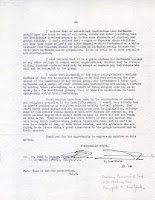The referendum was staged due to the desire of students to eliminate discriminatory clauses held in the constitutions of some of Dartmouth’s fraternities at the time. These clauses were established by the fraternities to prevent membership from men belonging to various groups of "race, religion, and national origin," and were most often found in chapters with national affiliation. These national fraternities were widely prejudiced, generally restricting membership to "white, Christian born males."
In his letter, White voices his opinions on the matter of racial and religious discrimination, referring to both the fraternity system and the greater United States. He utilizes his perspective and personal anecdotes in an attempt to argue that the enactment of the proposal by the undergraduate council would be unwise for the college and its students. One of his points of disapproval in the adoption of the proposal was his belief that Dartmouth's administration, through direct or indirect means, was forcing the fraternities to conform to the college's wishes and remove their discriminatory clauses. White's argument, however, was based on a misconception of the true driving force behind the fraternity desegregation movement.
Though Dartmouth’s administration acknowledged the issue of fraternity discrimination on campus as early as 1945, the acknowledgment was internal. Formal action on Dartmouth’s campus to desegregate its fraternity system was initiated entirely by students. Following the 1950 referendum, the investigations into each fraternity - to assess their progress towards the elimination of their discriminatory clauses - were led by a Discrimination Council composed of undergraduates appointed by the Interfraternity Council and the Undergraduate Council. The fraternity desegregation movement remained student-led, with approval from some faculty and administrative members, until May 6, 1954. The college enacted no official policy on fraternity discrimination until this date, and the policy resulted from a second student referendum and recommendation given to the Board of Trustees by the undergraduate council. You can find further information on the second referendum in the "Going Local: Desegregating Dartmouth's Fraternities" article here on Rauner's blog site.Dickey's presidential records have significantly aided my research during the Historical Accountability Student Research Program Fellowship, in which I am researching diversity and inclusion in Dartmouth's fraternities throughout the 20th century. As President of Dartmouth throughout the fraternity desegregation movement, Dickey's records contain an abundance of correspondence with college officers, students, alumni, and national fraternity representatives over the matter. W. Lee White’s letter is held in Dickey's files. Furthermore, Dickey played a major role in eliminating discriminatory clauses from fraternity chapters after the second referendum. He personally presented the results of the second student referendum to the Board of Trustees, spearheading the Board's decision to make the referendum's recommendation official college policy.
While Dickey received many letters from alumni in support of fraternities disaffiliating from their national chapters and removing their discriminatory clauses, W. Lee White's words parallel those of many national fraternity representatives and other alumni who wrote Dickey with disdain for the movement to eliminate the discriminatory clauses. Pro-discrimination letters like W. Lee White's provide evidence of the strong opposition Dickey and the college received during the fraternity desegregation period, and they document the severe divide in attitude over the issue by members of the Dartmouth community—all of which the college was able to overcome after more than a decade of conflict.
I invite anyone further interested in fraternity desegregation to consult Rauner’s extensive collection of records.

